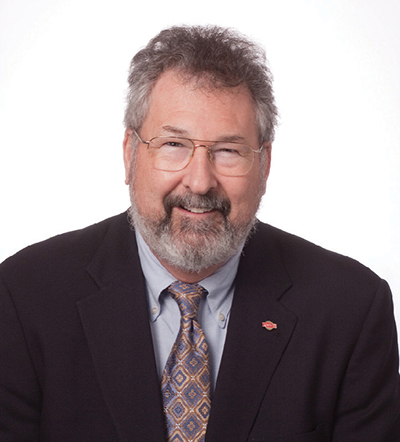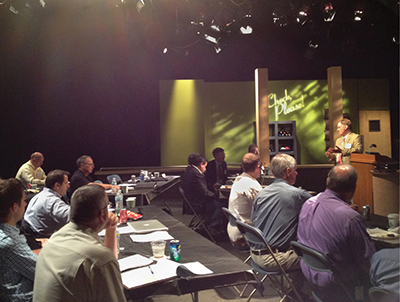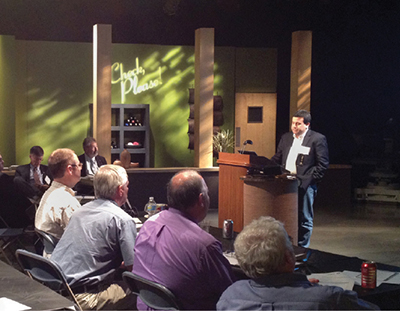Chicago Hosts First ATSC/SBE Loudness Seminar
CHICAGO—With the end-of-the-year deadline for CALM Act compliance briskly approaching, the ATSC and SBE joined forces to deliver the first of three seminars covering the new regulations. This first meeting was held in Chicago on Aug. 23, and subsequent meetings will be in Los Angeles (Sept. 27), and Atlanta (Nov. 13).

Pat Waddell of Harmonic was the moderator for the seminar on CALM Act compliance.
Hosted in the studios of pioneering PBS broadcaster WTTW, the Chicago event drew attendees from a mix of call-letter stations and content distributors, such as cable and satellite operators. The stated goal was to present “…FCC rules and updated information on the CALM Act, practical solutions for implementation, loudness measurement and monitoring technology, receiver processing and equipment solutions and an in-depth tutorial on ATSC’s recommended practice A/85.”
One of the several presenters was Pat Waddell, manager for standards and regulatory at Harmonic Inc. As part of Waddell’s responsibilities, he represents Harmonic in the ATSC, where he chairs the TG1/S6 specialist group on video and audio coding. Under S6 is the ad-hoc group S6-3 on audio loudness issues, chaired by Jim Starzynski of NBCUniversal.
“Recognizing the continuing need in the industry for education on this complex topic, the Chicago seminar and the two subsequent events in Los Angeles and Atlanta were planned by Jim Starzynski, myself and the ATSC staff, in cooperation with SBE,” Waddell said.
There were several presenters starting off with Waddell, who laid the groundwork for the day’s presentations.
“I spoke on two topics,” he said. “First, as an active leader within ATSC, to offer a background presentation on the organization, its history, its process and procedures. Second, as the TG1/S6 chair, I presented a detailed review of ‘Loudness Background,’ covering both the technical, standards-related and regulatory aspects of this topic.”
Get the TV Tech Newsletter
The professional video industry's #1 source for news, trends and product and tech information. Sign up below.
WORKING FROM THE INSIDE
Working from the inside as one of the standard’s creators, Waddell has a firm grasp of how we got to this point and where we need to go.
“This is a very complex subject,” he said. “The ATSC has been working on this for a long time, well before Congress entered the picture. Congress was going down a different path before it realized that the industry was already working on a solution.”

Jim Starzynski of NBCUniversal gives a presentation on what TV stations need to do to maintain compliance with the CALM Act.
The result is a regulation that reflects the actual working environment in which broadcasters find themselves. That’s not to say that complying with the new regulations will be easy.
“The FCC has been given a difficult challenge,” Waddell said. “The FCC’s Report and Order was mostly good news for the industry, as it starts with the assumption that program providers will do the right thing. [Well, gee, that includes every local news program!] Thus the urgent need for education.”
After Waddell’s opening presentation, Steve Lyman of Dolby Labs led a discussion on measurement and monitoring, including the ITU-R BS.1770 measurement algorithm. One of Lyman’s tips is to lock down the monitor pot, mix with your ears and proof the signal level with the meter.
With the ITU-R BS.1770 audio standard comes a new measurement unit: LKFS. LKFS stands for Loudness, K-weighted, relative to nominal full scale. The LKFS unit is equivalent to a decibel in the sense that an increase of 1 dB in the signal level will increase the loudness reading by 1 LKFS. (For more information on LKFS, read “LKFS and the CALM Act,” by Dave Moulton, Inside Audio, April 1, 2011).
“ Understand that we now live in an LKFS world,” Waddell said. “VU and PPM readings do not accurately measure perceived loudness—they are still useful as level indicators, but operators must use tools that incorporate the ITU-R BS.1770 measurement algorithm to measure content.”
With many senior technical employees in the industry having grown up with analog, there was a lot of interesting discussion about the ITU-R BS.1770 measurement algorithm and its associated measurement requirements.
ENSURING COMPLIANCE
Jim Starzynski, director and principal audio engineer for NBCUniversal Advanced Engineering, and chairperson of the Advanced Television Systems Committee technical subgroup S6-3 on digital television loudness, guided the session through the actions needed by broadcasters to ensure compliance with the regulations. This included an overview of best practices for production and short-form content creation. If you create content, the new guideline is that you should use an LKFS meter to measure and meet the specification of the recipient.
Tim Carroll of Linear Acoustic continued on the topic of what the new regulations mean for content creation. This included a discussion of loudness vs. dynamic range, and how increased perceived loudness using compression is not the way to go in an LKFS world. In order to effectively use the wide audio dynamic range of DTV (more than 100 dB), content loudness must be correctly managed or the unintended consequence of wide loudness variations will occur.

Tim Carroll of Linear Acoustic discussed how the new regulations affect content creation. Broadcasters are not the only parties affected by the new regulations—cable companies, satellite operators and other entities are also subject to the new rules. Dave Higgins of Comcast Cable picked up the discussion with an overview of what the regulations mean for multivideo program distributors (MVPDs), which is how such organizations are spelled out in the FCC’s Report and Order. The recommendation is for MVPDs to have a plan for how various types of content will be loudnessnormalized within their stations or plants, based on workflows that incorporate the recommendations contained in ATSC A/85.
The last of the discussions revolved around the anticipated experience for home viewers, led by Steve Silva of Fox. Silva reviewed the AC-3 DTV distribution system and what broadcasters need to know about dialnorm.
One suggestion by Silva was to use a Dolby LM100 loudness meter to monitor ATSC audio in a consumer system. The LM100 measures the subjective loudness of dialogue within broadcast programming and can give a measurement of subjective loudness, based on the ITU-R BS.1770 measurement algorithm.
Waddell concluded the day with a panel discussion.
Although CALM Act compliance seems complex and another burden of government regulation, there are some aspects of the new regulations that will make it easier for broadcasters and MVPDs. With sound quality in mind, the FCC is urging program providers to “certify” that their content will “comply” with the recommendations in A/85. Those downstream who simply pass the certified content through are given a “safe harbor” unless there is a “pattern of complaints.”
Certified passthrough is desirable to the programmer, as it permits already-compliant content to reach the audience unaltered, just as the content creator intended. It’s important to the MVPD, as it requires no costly or complicated intervention by the downstream distributor. In the event a complaint arises, the downstream operator (either TV station or MVPD) must perform a “spot check” to see if it can find the source of the problem.
Two more ATSC/SBE seminars will occur before the new audio rules take effect on Dec. 13. If you are responsible for implementing this at your facility, you should be asking about attending one of these two presentations. For more information, visit http://sbe36.org/loudness-seminars/.
Bob Kovacs is the former Technology Editor for TV Tech and editor of Government Video. He is a long-time video engineer and writer, who now works as a video producer for a government agency. In 2020, Kovacs won several awards as the editor and co-producer of the short film "Rendezvous."

